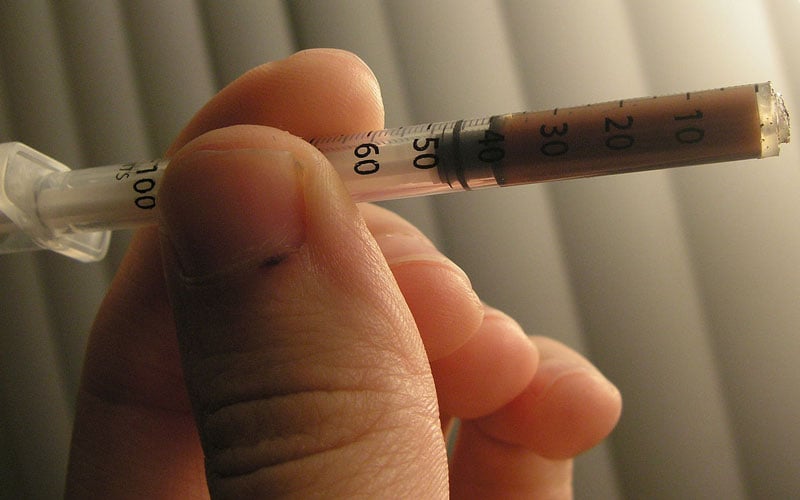Despite efforts to slow the scourge of heroin and prescription drug abuse, the number of emergency room admissions from heroin and narcotic pill overdoses have continued to rise across Arizona.
Recent data from the Arizona Department of Health Services shows that 1,052 people required emergency room treatment for prescription drug overdoses in 2014, up from 1,018 in the previous year. Heroin overdoses increased from 521 in 2013 to 605 in 2014.
“Most drug abuse, specifically in the heroin arena starts by using legal prescription drugs, 75 percent in fact,” said Christina Corieri, Gov. Doug Ducey’s health and human services advisor. “So if we can identify individuals up front who are at risk of becoming addicted, we can intervene and help them and save lives.”
Pharmaceutical opiates overdose mortality rates by county:
- Gila: >20 deaths per 100,000 people.
- Mohave: >15 deaths per 100,000 people.
- Pima: >10 deaths per 100,000 people.
- Maricopa: 5 deaths per 100,000 people.
- Navajo: >5 deaths per 100,000 people.
- Yavapai: >5 deaths per 100,000 people.
Data from Arizona Department of Health Services
Overdose deaths also increased across the board from 2013 to 2014, according to the data from AZDHS. In 2014, there were 494 deaths recorded from pharmaceutical opioids and benzodiazepines, a 16 percent increase from the previous year. Heroin-caused deaths jumped from 125 in 2013 to 180 in 2014, a 44 percent increase.
Prescription pill abuse has exploded nationally over the last 20 years. According to the Centers for Disease Control, fatal drug overdoses outnumbered fatal car crashes and shootings in 2013.
“If you look at the United States we actually represent only 5 percent of the world’s population, and we represent 80 percent of the prescription drugs,” said Corieri.
Brittany Pinkston, a behavioral health technician, was introduced to opiates at age 17 after a hand injury sent her to an urgent care center in Gilbert. She said she didn’t consider herself an addict because the drugs came from a doctor. Within a month, she was physically addicted to pills – too sick to sleep or work if she didn’t have narcotics.
“I could easily go to urgent care and they’d prescribe it to me in a second. I know exactly what to say. You just go in and say your back hurts and they’ll give you Percocet. I got one in the waiting room once,” she said.
She justified her drug use because she could function so well on the pills and “that’s serious denial,” she said.
“How bad can they be?” she added. “They came from a doctor.”
“The funny thing is you think you’re not that bad until you can’t get the doctor to prescribe you pills, and then you’re like holy shit, this is a problem,” Pinkston added.
She said that once, while she was “dope sick” and trying to refill her stash, a doctor noticed her fever and withdrawal symptoms and told her, “If you need more, you can come back.”
Dr. Dan Quan, a toxicologist who works in the emergency room at Maricopa Integrated Health System, sees patients who have overdosed every day.
“I had one patient who said he was hurt at age eight and that’s how he got addicted to pain medication. He didn’t know any better because he was so young, it just kept escalating from there,” he said.
He said usually people are first exposed to opiates in an emergency room setting.
“A high school football player who breaks his leg, or someone who gets in a nasty car accident; these people usually have no idea they are dealing with deadly and highly addictive substances,” said Quan.
“And when they can’t get pills to feed the habit, they buy their first bag of heroin, which is cheaper and sometimes easier to find than the pills,” he added.
Nick Sanders works as a coordinator at a Valley drug rehab center. He first tried Percocet when a high school friend gave him the drugs for free.
“When I first got high it really felt like the heavens had parted, I found what I should be doing finally. I was always anxious, but it seemed like all I had to do was a little bit of a pill and I was good for the rest of the day,” he said.
“I was exactly where I had to be.”
Nick’s addiction consumed him throughout his teenage years, fueled further by drug dealing and eventually armed robbery.
“And that’s kind of a common theme in drug use and substance abuse, you rob people. I had never done that, because I never wanted to hurt somebody,” said Sanders.
But Sanders said when he needed money, stealing drugs from a pharmacy at gunpoint seemed like the safest way to get the pills that he needed.
He decided to rob a Walgreens, hiding his face with large sunglasses and a tissue over his nose. The robbery note was disguised as a doctor’s prescription.
“I flash him the gun real quick, he hands me the pills, and I pretty much just walk out the fire exit,” he said.
In 2007, the Arizona State Board of Pharmacy set up the “Controlled Substances Prescription Monitoring Program” to prevent doctor shopping and over-prescribing. The program is an online database for doctors to document every instance in which they prescribe narcotic medications. When using the database, a physician can see if their patient has been prescribed narcotics recently.
Use of the database is voluntary, but that may soon change.
Arizona legislators are trying to pass a bill that legally requires the doctors to use the program. State Sen. John Kavanagh, R-District 8, sponsored the bill after Ducey called for its mandatory use.
“In order to save lives, and prevent all the accidents and crime and heartache that follow opiate overdose or intoxication, we’re going to mandate it, because it has to be done,” said Kavanagh.
